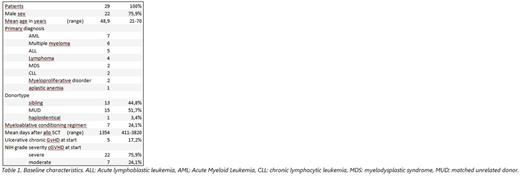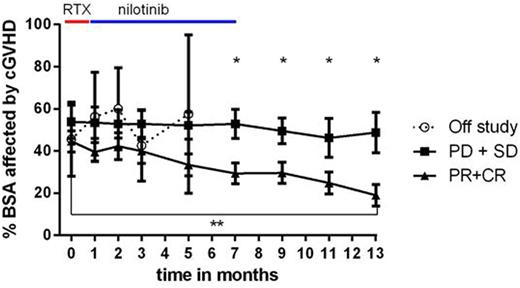Abstract
Introduction
Chronic Graft Versus Host Disease (cGVHD) has a large impact on morbidity and mortality after allogeneic hematopoietic stem cell transplantation (HSCT). Therapeutic approaches for cGVHD are limited. Affected patients require long-term use of immunosuppressive drugs, mainly corticosteroids combined with a calcineurin inhibitor, which lead to severe side effects. Options for second line therapy are numerous but no consensus on the most favourable choice of agents has been reached. Both monotherapy with rituximab (Cutler, Miklos et al. 2006, Kharfan-Dabaja, Mhaskar et al. 2009, van Dorp, Resemann et al. 2011) and monotherapy with tyrosine kinase inhibition (Magro, Mohty et al. 2009, Olivieri, Locatelli et al. 2009) have shown to be effective in reducing cGVHD symptoms.
Materials and Methods
We performed a prospective study to test whether the sequential therapy of the anti-CD20 antibody rituximab followed by a 6 month treatment period with nilotinib, a tyrosine kinase inhibitor, is a favorable treatment strategy for patients with sclerotic cGVHD (EudraCT nr 2008-004125-42). All patients were evaluated monthly according to NIH cGVHD consensus response criteria working group recommendations from 2005. Serial blood sampling was performed every other month.
Results
We included 29 patients, 5 patients went offstudy (1 with side effects rituximab, 2 with gastro-intestinal side effects nilotinib, 1 patient had progression of M. Hodgkin, 1 patient due to viral encephalitis with cognitive impairment), 24 are available for analysis. Baseline characteristics are depicted in table 1. We observed a response in 71% (2 patients CR, 15 patients PR). Only 1 patient showed progressive disease (PD) and the remaining 6 patients showed stable disease (SD). Moreover, 2 out of 5 patients who suffered from severe ulcerations at the start of the study had a complete resolution of ulcers at the end of the treatment period. Responding patients show a significant decrease in cGVHD affected body surface area (Figure 1) mostly explained by a significant reduction in nonmoveable sclerosis. Patients with a (partial) response also show a clinically relevant decrease in self attributed severity of cGVHD. On a scale of 10 points their self-attributed cGVHD severity decreased in the PD+SD group with a mean of 0,3 points whilst in the PR+CR group there was a mean decrease of 2,4 points. Fifty percent of responding patients could taper >50% of their daily prednisolone dose at the end of the study period. Other immunosuppressive drugs (ciclosporin, MMF) could also be tapered. Rituximab was well tolerated except for 1 patient who showed a neurological syndrome resembling Guillain Barre after 2 infusions and therefor went offstudy. Nilotinib was dosed 300mg b.i.d. however only 9 patients tolerated this dose without side effects. For the remaining patients the dose was decreased to 200mg b.i.d. which was well tolerated for the majority. Most encountered side effects included fatigue, nausea, pain in extremities and prolonged QT-interval on standard ECG monitoring.
Conclusions
The combination of B-cell depletion and tyrosine kinase inhibition provides a new and interesting alternative treatment option for this difficult and heavily pretreated patient category. Approximately 70% of patients achieve a (partial) response with a decrease of sclerosis, an improved quality of life and a significant reduction in the use of corticosteroids. Two patients reached a complete resolution of all cGVHD related symptoms which is seldom achieved. How to prospectively designate which patients will benefit from this treatment strategy is currently under investigation.
Percentage of body surface area (BSA) affected by cGVHD during the study period. From month 7 onwards there was a significant difference between PD+SD patients and PR+CR patients (t-test corrected for multiple testing by means of Sidak-Bonferroni method). Comparing start and end of the study PR+CR patients show a significant reduction in BSA affected by cGVHD (paired Wilcoxon matched pairs signed rank test). Mean and s.e.m. are depicted. BSA: Body Surface Area, CR: complete response, PD: progressive disease, PR: partial response, RTX: rituximab, SD: stable disease.
Percentage of body surface area (BSA) affected by cGVHD during the study period. From month 7 onwards there was a significant difference between PD+SD patients and PR+CR patients (t-test corrected for multiple testing by means of Sidak-Bonferroni method). Comparing start and end of the study PR+CR patients show a significant reduction in BSA affected by cGVHD (paired Wilcoxon matched pairs signed rank test). Mean and s.e.m. are depicted. BSA: Body Surface Area, CR: complete response, PD: progressive disease, PR: partial response, RTX: rituximab, SD: stable disease.
Kuball:Gadeta B.V,: Membership on an entity's Board of Directors or advisory committees.
Author notes
Asterisk with author names denotes non-ASH members.



This feature is available to Subscribers Only
Sign In or Create an Account Close Modal